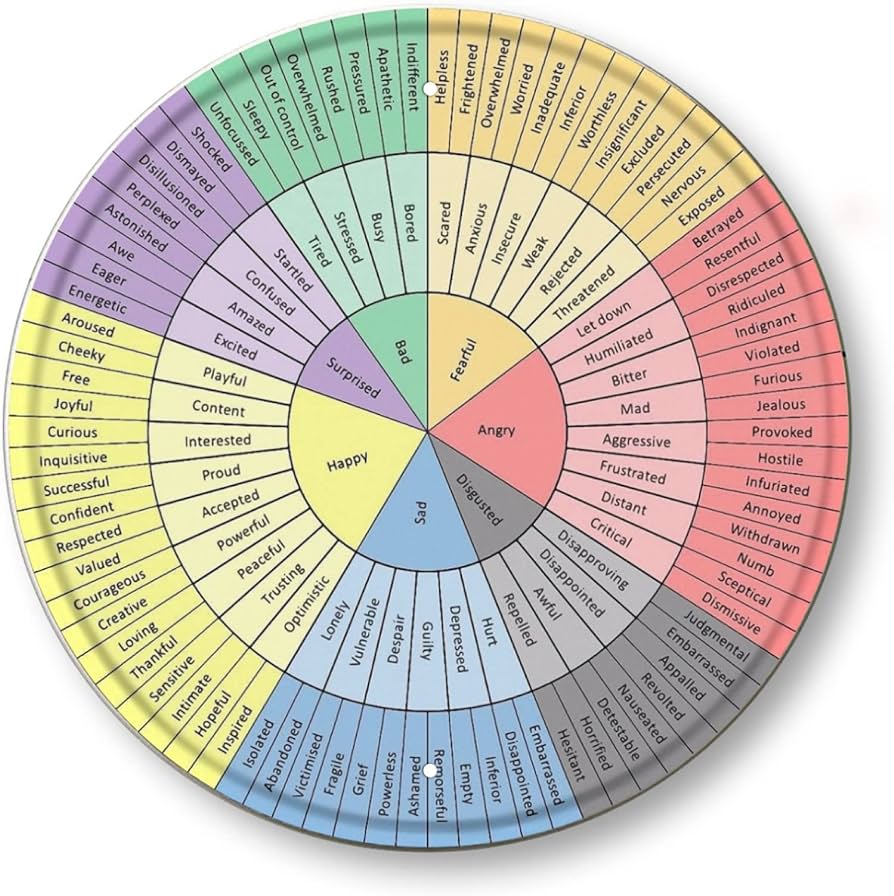Are you feeling overwhelmed and frustrated but can’t seem to put your finger on why? Does it feel like the world is closing in, and it’s hard to take a deep breath and re-center yourself? It can be difficult for us to express our feelings in times like this. That’s where The Feelings Wheel comes into play – an innovative tool designed to help expand your emotional vocabulary and allow you to distinguish between different types of feelings. In this blog post, we’ll explore how this simple tool can negotiate stress levels and increase self-awareness by providing a canvas for emotions beyond traditional words.

What is the feelings wheel, and how does it work?
The feelings wheel is a helpful tool for self-reflection and emotional exploration. Developed by Dr. Gloria Willcox, it provides a comprehensive visual presentation of human emotions that can guide us to an understanding of our current emotional state. The system is based on eight core moods: joyful, determined, peaceful, energetic, compassionate, scared, angry, and ashamed. Each emotion sits at the center of the wheel and has its color coding. Each emotion also distinguishes itself with four levels of intensity that branch out from the core feeling – vignettes to illustrate what each emotion entails in terms of body language and attitudes. By taking the time to familiarize ourselves with this colorful chart of emotions, we can become more aware of our internal states and reactions to external stimuli.
How can the feelings wheel help you in your everyday life?
It helps people distinguish between the various feelings they experience by providing them with clear examples. The feelings wheel can be especially helpful in recognizing otherwise imperceptible or vague emotions, allowing us to better reflect on our inner states. Using the wheel can provide insights into our emotional makeup and enable us to take steps to improve our mental health. Its straightforward layout also serves as a conversation starter, allowing us to express more easily what we are going through with others. Implementing the feelings wheel into your everyday life can open new pathways of understanding that can lead to valuable self-awareness and healthier coping mechanisms.
Examples of how to use the feelings wheel
By utilizing this method, people can expand their vocabulary for discussing emotions with others. People can use the feelings wheel to express their emotions better and more accurately identify what others are feeling. Utilizing its descriptive categories of emotion, this tool presents a visual representation of how complex emotions can be broken down and discussed in manageable pieces to assist in effectively describing any feeling. This simplified approach to discussing emotions helps participants hone into exactly how they or others may feel when faced with a particular situation. The feelings wheel helps create empathy among users by providing an opportunity to understand someone else’s perspective. It effectively bridges the communication gap while engaging in meaningful discussion by providing a shared language for expressing feelings.
The benefits of using the feelings wheel
The feelings wheel helps you identify your emotional state through visual representation—by depicting each emotion in a circle or “wheel” shape, allowing you to quickly identify where your current emotional state lies on the spectrum. Additionally, the feelings wheel can be used to gain insight into how others may feel by identifying which emotions they express outwardly. This can help facilitate more effective conversation and interpersonal relationships.
Using the feelings wheel can also provide clarity when reflecting upon past events or conversations; breaking down each interaction into its components (i.e., emotions and thoughts) makes it easier to analyze what went wrong or right in a particular situation. This can help you better understand yourself and others, allowing you to interpret behavior more accurately and respond accordingly.
The feelings wheel also allows for self-reflection by allowing individuals to gain insight into their emotional states without needing external validation from another person. Understanding your feelings can build self-awareness and clarity about important life decisions, relationships, and overall well-being. Thus, using the feelings wheel as a tool for self-discovery has the potential to have a profoundly positive effect on one’s mental health.
Overall, using the feelings wheel is a helpful tool for understanding yourself and others better, which can aid in communication, reflection, and self-awareness. By recognizing and accepting your feelings and the feelings of those around you, you can foster stronger interpersonal relationships and become a more emotionally intelligent individual.
Conclusion
The feelings wheel is a great tool in your emotional intelligence arsenal. By expanding your vocabulary and ability to explain your emotions, you can better communicate with others, manage stress, resolve conflict, and build healthier relationships. Give it a try the next time you’re feeling something complex or difficult to describe – you may be surprised at how well it works.


